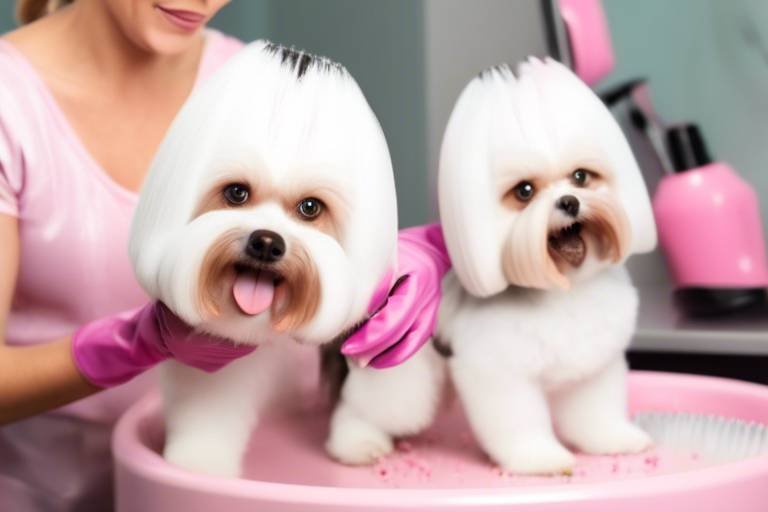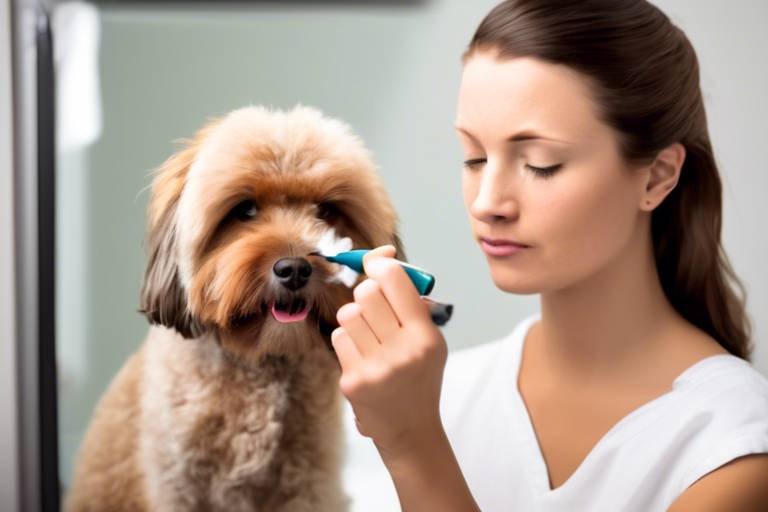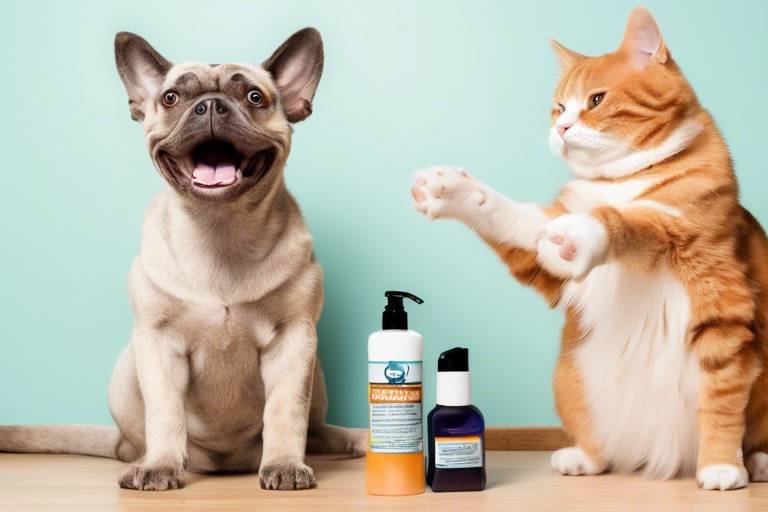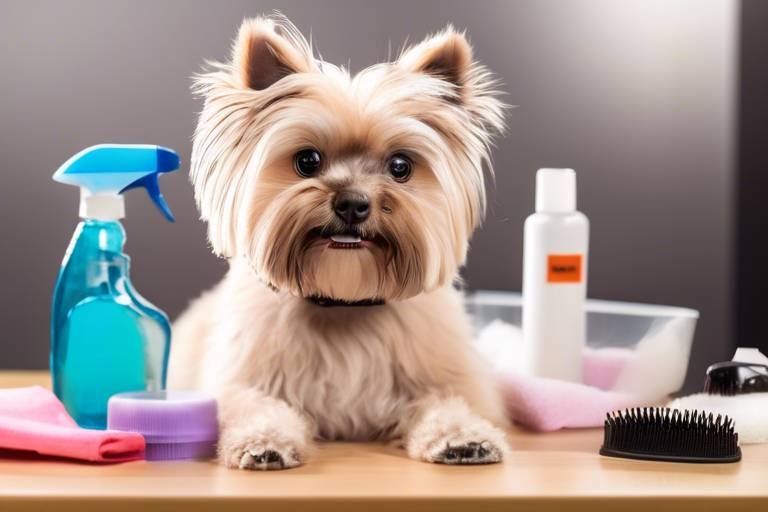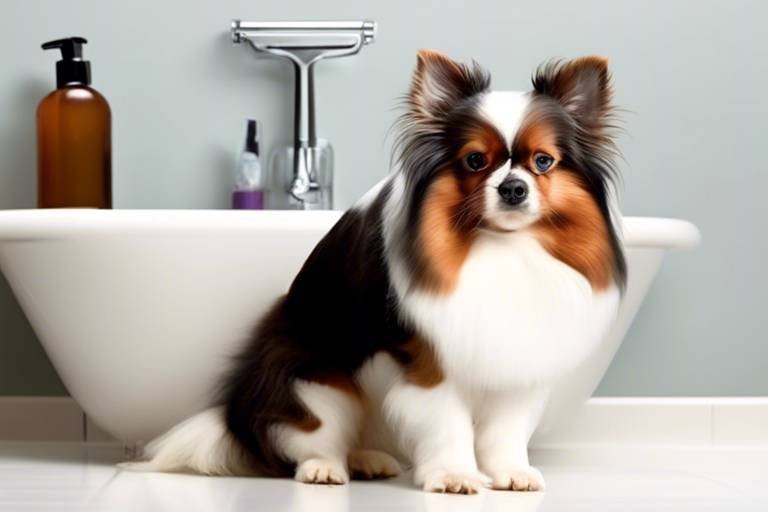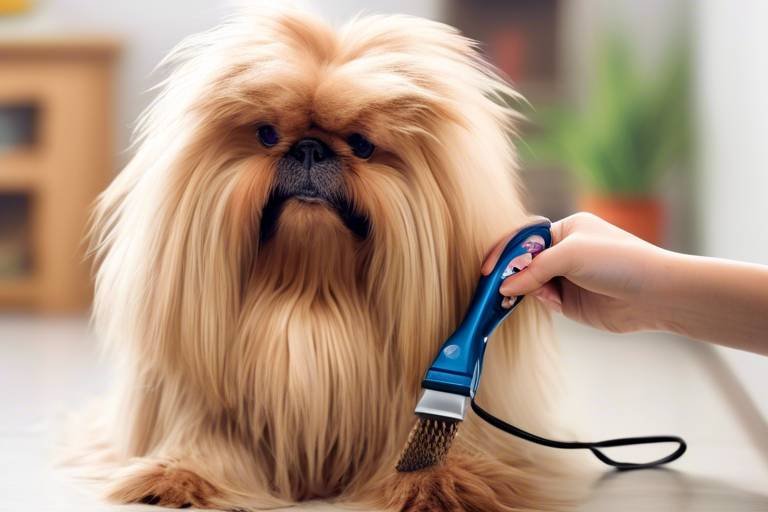How to Groom Your Pet for the Summer
As the temperatures rise and the sun shines brighter, it's crucial to ensure that your furry friends are well-groomed and comfortable. Summer can be a challenging time for pets, especially those with thick fur or specific grooming needs. The right grooming routine not only enhances your pet's appearance but also plays a significant role in their overall health and happiness. By taking the time to understand your pet's unique grooming requirements, you can create a tailored plan that makes them feel fresh and ready to enjoy the warm weather. After all, who doesn’t want to see their pet frolicking happily in the sun, free from discomfort and irritation?
In this article, we will explore essential grooming tips and techniques to keep your pet looking and feeling their best during the summer months. From understanding your pet's specific grooming needs to choosing the right tools and managing skin care, we’ve got you covered. So, let’s dive in and ensure that your beloved companion is summer-ready!
Every pet is unique, and so are their grooming needs. Some pets may require regular brushing to prevent matting, while others might need occasional trimming to keep their coat manageable. Understanding these specific needs is the first step toward establishing a grooming routine that suits your pet perfectly. For instance, long-haired breeds often need more frequent grooming compared to short-haired ones, especially during the hot months when shedding tends to increase.
Additionally, consider your pet’s activity level and lifestyle. If they spend a lot of time outdoors, they may be exposed to dirt, mud, and pests, necessitating more frequent baths and grooming sessions. On the other hand, if your pet is more of a couch potato, you might find that a less rigorous grooming schedule is sufficient. Whatever the case, paying close attention to your pet’s individual needs will help you keep them comfortable and healthy throughout the summer.
Having the right grooming tools at your disposal can make all the difference when it comes to effectively grooming your pet. Whether your furry friend has long, flowing fur or a short, sleek coat, there are specific tools designed to tackle various grooming challenges. Investing in quality grooming supplies not only makes the process easier but also ensures that your pet enjoys the experience.
Using the right brushes and combs can significantly reduce shedding and prevent matting. For example, slicker brushes are fantastic for removing loose fur and tangles in long-haired breeds, while bristle brushes work wonders on short-haired pets by distributing natural oils and keeping their coat shiny. It’s essential to choose brushes that cater to your pet’s coat type to maintain their fur’s health and appearance.
For those pets that shed heavily during the summer, de-shedding tools are a must-have. These tools are designed to reach down to the undercoat, removing loose hair without damaging the top layer. Regular use of de-shedding tools can help keep your home cleaner and your pet more comfortable. It’s best to use these tools during the shedding season to achieve optimal results.
Clippers and scissors are vital for trimming fur and keeping your pet looking neat. When choosing clippers, look for ones that are quiet and have adjustable blade lengths to accommodate different fur types. Scissors with rounded tips are ideal for trimming around sensitive areas to avoid accidental nicks. Always prioritize safety and comfort when using these tools, and if you're unsure, consider consulting a professional groomer for guidance.
Bathing your pet properly is crucial during the hot summer months. While some pets may need weekly baths, others might only require a bath every month or so. The key is to use a gentle, pet-friendly shampoo that won’t irritate their skin. When bathing, ensure the water is lukewarm, as hot water can be uncomfortable for your pet. After the bath, thoroughly rinse to remove all shampoo residue, as leftover soap can lead to skin irritation.
Drying your pet after a bath is equally important. You can use a towel for drying, but a pet-safe blow dryer on a low setting can help speed up the process. Just be sure to keep the dryer at a safe distance to avoid overheating their skin. With the right bathing techniques, your pet will not only smell great but will also feel cool and comfortable during the summer heat.
Summer can bring about various skin issues for pets, so it’s essential to be proactive in managing their skin health. Common problems include hot spots, sunburn, and insect bites. By understanding these issues, you can take effective measures to keep your pet’s skin healthy and irritation-free throughout the season.
Fleas and ticks thrive in warm weather, making it essential to take preventive measures. Regularly checking your pet for these pests, especially after outdoor activities, can help catch infestations early. Consider using veterinarian-recommended flea and tick prevention products to keep your pet safe. If your pet does become infested, consult your vet for effective treatment options to ensure their health and well-being.
Just like humans, pets can suffer from sunburn, particularly those with light-colored fur or exposed skin. To protect your pet from harmful UV rays, consider using pet-safe sunscreen on vulnerable areas such as their nose, ears, and belly. Additionally, providing shade during outdoor activities and limiting sun exposure during peak hours can help keep your pet safe from sunburn. Remember, a little precaution can go a long way in ensuring your pet enjoys a fun and safe summer!
- How often should I groom my pet in the summer? It depends on your pet's coat type. Long-haired pets may need grooming several times a week, while short-haired ones might only require it once a week.
- Can I use human shampoo on my pet? No, human shampoo can irritate your pet's skin. Always use products specifically formulated for pets.
- What should I do if I find fleas on my pet? Consult your veterinarian for the best flea treatment options and consider using preventive measures moving forward.

Understanding Your Pet’s Grooming Needs
Every pet is unique, and just like humans, they have their own specific grooming needs that can vary widely based on their breed, size, and individual health. Understanding these needs is crucial for ensuring that your furry friend stays healthy and comfortable, especially during the hot summer months. For instance, a long-haired Golden Retriever will have different grooming requirements compared to a short-haired Chihuahua. So, what exactly should you consider when it comes to grooming your pet?
First and foremost, consider the type of coat your pet has. Long-haired pets often require more frequent brushing to prevent tangles and mats, while short-haired breeds may only need occasional brushing to remove loose hair. Additionally, pets with curly or wiry coats might benefit from specialized grooming tools to maintain their coat's texture and prevent matting. Understanding your pet's coat type will help you choose the right grooming schedule and tools.
Next, think about your pet's activity level and environment. If your pet loves to romp around outside, they may pick up dirt, debris, and even pests like ticks or fleas, which means they might require more regular baths and grooming sessions. On the other hand, if your pet is more of a couch potato, they might need less frequent grooming. It's all about tailoring the grooming routine to fit your pet's lifestyle.
Moreover, keep an eye on your pet’s skin health. Summer can bring about various skin issues such as irritations or allergies, particularly if your pet spends a lot of time outdoors. Regular grooming can help you spot any unusual changes in your pet's skin or coat early on, allowing for timely intervention. Check for signs of redness, itching, or unusual lumps during your grooming sessions, and consult your veterinarian if you notice anything concerning.
Finally, don't forget about your pet's comfort. Grooming should be a positive experience, so make sure to use tools that are gentle on your pet's skin and fur. If your pet seems anxious or uncomfortable during grooming, consider introducing them to the process gradually or using treats to create a more enjoyable atmosphere. Remember, a well-groomed pet is not only more comfortable but also healthier and happier!

Choosing the Right Grooming Tools
When it comes to grooming your pet, choosing the right tools is just as important as the grooming process itself. Imagine trying to paint a masterpiece without the right brushes; the same concept applies to pet grooming. Each pet has its own unique coat type, and understanding this will help you select the most effective tools to keep your furry friend looking fabulous and feeling comfortable. Whether your pet has long, flowing fur or a short, sleek coat, there are specific tools designed to cater to their needs.
First off, let’s talk about brushes and combs. These tools are essential for maintaining the health of your pet's coat. A good brush can help prevent matting and reduce shedding, which is especially important in the summer months when your pet’s coat may be more prone to tangles due to humidity. For instance, if you have a long-haired breed like a Golden Retriever, a wide-toothed comb or a slicker brush can work wonders in detangling and smoothing their fur. On the other hand, short-haired breeds like Beagles can benefit from a rubber curry brush that effectively removes loose hair while providing a nice massage.
Next, we have de-shedding tools. If your pet is a heavy shedder, investing in a high-quality de-shedding tool can save you a lot of time and effort. These tools are designed to reach beneath the top layer of fur to remove loose undercoat hair, which is often the culprit behind excessive shedding. Using a de-shedding tool once a week can significantly reduce the amount of fur left on your furniture and floors. Just remember, moderation is key; overusing these tools can irritate your pet's skin, so be gentle and follow the manufacturer’s instructions.
Additionally, let’s not overlook the importance of clippers and scissors. If you have a pet that requires regular trims or a specific grooming style, a good pair of clippers or scissors is essential. For example, breeds like Poodles or Shih Tzus often need their fur trimmed to maintain their signature look. When choosing clippers, look for ones that are quiet and have adjustable blade lengths to cater to different areas of your pet's body. Safety is paramount, so ensure you’re comfortable using them and consider practicing on a stuffed animal first if you’re a novice.
Lastly, don’t forget about bath products. During the summer, bathing your pet can help keep their coat clean and free from dirt and allergens. Choose shampoos that are specifically formulated for pets, as human shampoos can disrupt their skin's natural pH balance. Also, consider adding a conditioner to their grooming routine to keep their fur soft and manageable. After bathing, ensure your pet is dried properly; using a pet-friendly towel or a blow dryer on a low setting can help keep them comfortable and prevent any skin irritation.
In summary, selecting the right grooming tools is crucial for maintaining your pet’s health and comfort during the summer months. With the right brushes, de-shedding tools, clippers, and bath products, you can ensure that your furry friend stays looking and feeling their best. Remember, grooming is not just about aesthetics; it’s about keeping your pet healthy, happy, and free from discomfort.
- How often should I groom my pet in summer? It depends on your pet's coat type. Long-haired breeds may need grooming several times a week, while short-haired breeds might only require it once a week.
- What if my pet hates being groomed? Start slowly, using treats and praise to create a positive association. Gradually increase the duration of grooming sessions.
- Can I use human grooming products on my pet? No, human grooming products can disrupt your pet's skin pH balance. Always use products specifically designed for pets.
Brushes and Combs
When it comes to grooming your furry friend, choosing the right brushes and combs is absolutely essential. Just like we have different hairstyles and needs, pets have unique coat types that require specific tools to keep their fur healthy and tangle-free. Imagine trying to untangle a massive ball of yarn with a tiny comb—frustrating, right? That’s exactly how your pet feels if you use the wrong grooming tool!
First off, let’s dive into the types of brushes available. For pets with long hair, a slicker brush is your best friend. It effectively removes mats and tangles, making it easier to maintain their luxurious locks. On the other hand, if your pet has a short coat, a bristle brush or a rubber curry brush can work wonders in removing loose hair and distributing natural oils throughout their coat. Think of it as giving your pet a mini massage while also keeping their fur shiny and healthy!
Now, let’s not forget about combs! A comb is perfect for getting into those tricky spots. Use a wide-toothed comb for detangling and a fine-toothed comb for removing any pesky debris or parasites. This is especially important for pets that love to roll around outside. You wouldn’t want them bringing home a little extra ‘nature’ with them, would you?
To help you understand which tools are best for your pet, here’s a quick comparison table:
| Coat Type | Recommended Brush | Recommended Comb |
|---|---|---|
| Long Hair | Slicker Brush | Wide-toothed Comb |
| Short Hair | Bristle Brush | Fine-toothed Comb |
| Curly Hair | Pin Brush | Wide-toothed Comb |
Additionally, it’s crucial to groom your pet regularly, especially during the summer months when shedding peaks. Not only does this keep your home free of fur, but it also helps in identifying any skin issues early on. Regular grooming can be a bonding experience too! Imagine curling up on the couch with your pet, brushing their fur while they enjoy the attention. It’s a win-win!
In conclusion, investing in the right brushes and combs is not just about aesthetics; it’s about your pet’s overall health and happiness. So, the next time you’re in the pet store, take a moment to consider your pet’s unique grooming needs. After all, a well-groomed pet is a happy pet!
De-shedding Tools
As the summer heat rolls in, our furry friends often shed their winter coats, leaving behind a trail of fur that can quickly transform your home into a pet hair haven. This is where come into play. These specialized grooming instruments are designed to help manage shedding, ensuring that both you and your pet can enjoy the warmer months without the hassle of excessive fur everywhere. But what exactly are de-shedding tools, and how do they work?
De-shedding tools typically come in various forms, including brushes, combs, and even grooming gloves. Each type serves a specific purpose and can be more effective depending on your pet’s coat type. For instance, a slicker brush is fantastic for removing loose fur and preventing matting in long-haired breeds, while a de-shedding rake is particularly effective for short-haired dogs that tend to shed heavily. By using the right tool, you can significantly reduce the amount of fur your pet leaves behind.
When choosing a de-shedding tool, consider the following factors:
- Coat Type: Different tools work better with different fur types. Long-haired pets may benefit from a slicker brush, while short-haired pets might need a rubber curry brush.
- Shedding Season: During peak shedding seasons, such as spring and summer, you may need to use these tools more frequently to keep up with the fur that’s flying around.
- Comfort: Always ensure that the tool you choose is comfortable for both you and your pet. Some pets may be sensitive to certain materials or brush types.
Using de-shedding tools effectively involves more than just brushing your pet's fur. It’s essential to follow a few best practices to maximize their effectiveness:
- Brush Regularly: Aim to brush your pet at least once a week, or more often during peak shedding periods. This will help keep the fur under control and prevent matting.
- Be Gentle: Always use gentle strokes, especially in sensitive areas like the belly and behind the ears. Your goal is to remove loose fur without causing discomfort.
- Check for Skin Issues: While grooming, keep an eye out for any signs of skin irritation or parasites. Early detection can save your pet from further discomfort.
In addition to reducing shedding, using de-shedding tools can also enhance your pet’s overall coat health. Regular grooming stimulates the skin and promotes healthy oil distribution, which can make your pet’s fur shinier and softer. Plus, it’s a great way to bond with your furry friend! So, grab those de-shedding tools and make grooming a fun, enjoyable experience for both you and your pet.
Q: How often should I use de-shedding tools on my pet?
A: It depends on your pet's coat type and shedding patterns. Generally, brushing once a week is effective, but during shedding seasons, you may want to do it more frequently.
Q: Can I use human hair brushes on my pet?
A: It's not recommended. Pet grooming tools are specifically designed for the unique texture and needs of animal fur, ensuring a more comfortable experience for your pet.
Q: What should I do if my pet doesn’t like being groomed?
A: Start slowly and make grooming a positive experience. Use treats and praise to encourage your pet, and consider shorter grooming sessions to help them get used to the process.
Clippers and Scissors
When it comes to grooming your pet, are your best friends. They not only help maintain a neat appearance but also ensure your furry companion is comfortable during the hot summer months. Choosing the right tools can make all the difference, especially for pets with varying coat types. For instance, long-haired breeds often require more frequent trims to prevent mats and tangles, while short-haired pets may just need a light touch-up to keep them looking sharp.
Before diving into the world of clippers and scissors, it’s essential to understand the different types available. Clippers come in various sizes and styles, each designed for specific grooming tasks. For example, a cordless clipper is excellent for maneuverability, allowing you to reach tricky spots without being tethered to an outlet. On the other hand, a heavy-duty clipper is perfect for thicker coats, providing the power needed to get through dense fur.
When selecting scissors, you’ll find options tailored for different needs. Thinning shears are fantastic for reducing bulk in thick fur without sacrificing length, while straight scissors are ideal for precise trims around sensitive areas like the face, paws, and tail. Always opt for high-quality grooming scissors to ensure safety and efficiency. Dull scissors can tug at your pet’s fur, causing discomfort and making the grooming experience unpleasant for both of you.
Safety is paramount when using clippers and scissors. Always start with clean, dry fur to avoid any mishaps. If your pet is anxious, consider using a calming spray or playing soothing music to help them relax. It’s crucial to keep your movements gentle and steady. Remember, you’re not just trimming fur; you’re also building trust with your pet. A calm environment will make the grooming process smoother and more enjoyable.
After grooming, always reward your pet with a treat or some playtime. This positive reinforcement turns grooming into a fun activity rather than a chore. Plus, it strengthens the bond between you and your furry friend, making future grooming sessions easier. So, grab those clippers and scissors, and let’s make your pet summer-ready!
- How often should I use clippers and scissors on my pet? It depends on your pet's coat type and length. Long-haired pets may need grooming every 4-6 weeks, while short-haired pets might only need a trim every couple of months.
- Can I use human clippers on my pet? It's not recommended. Pet clippers are designed specifically for animal fur, which is different in texture and density compared to human hair.
- What should I do if my pet is scared of clippers? Try desensitizing them by letting them see and sniff the clippers before using them. Gradually introduce the sound and feel of the clippers during playtime.
- How do I clean my clippers and scissors? After each use, wipe them down with a clean cloth and use a clipper blade cleaner to maintain their sharpness and hygiene.
Bathing Techniques
Bathing your pet during the summer months is not just about keeping them clean; it’s a vital part of ensuring their comfort and health as temperatures rise. A good bath can help wash away dirt, allergens, and excess oils that can build up on their skin, leading to irritation and discomfort. But how often should you bathe your furry friend? Well, that largely depends on their breed, coat type, and lifestyle. For instance, dogs that love to roll in the mud or play in the water might need more frequent baths than a cat that primarily stays indoors.
When it comes to the actual bathing process, preparation is key. Start by gathering all the necessary supplies, including a pet-friendly shampoo, towels, and a non-slip mat to prevent any accidents during the bath. It’s crucial to choose a shampoo that suits your pet’s specific skin type. For example, if your pet has sensitive skin, look for hypoallergenic options. Additionally, consider using conditioners that can help keep their coat soft and manageable.
Now, let’s dive into the bathing process itself. Here’s a simple step-by-step guide to make the experience enjoyable for both you and your pet:
- Start with a good brush: Before you even think about water, give your pet a good brushing. This helps to remove loose fur and tangles, making the bathing process smoother.
- Use lukewarm water: Pets can be sensitive to temperature, so always ensure the water is lukewarm. Too hot or too cold can be uncomfortable.
- Wet and lather: Use a handheld sprayer or a cup to wet your pet’s coat thoroughly. Then, apply the shampoo, lathering it gently into their fur, taking care to avoid their eyes and ears.
- Rinse thoroughly: It’s essential to rinse out all the shampoo to prevent skin irritation. Make sure to check for any residue, especially in thicker fur.
- Drying: After rinsing, gently towel dry your pet. If they’re comfortable with it, you can use a pet-safe blow dryer on a low setting. Always keep the dryer at a safe distance from their skin.
Remember, bathing can be a fun bonding experience! Use treats and praise to create a positive association with bath time. Some pets might even enjoy playing with toys in the water, making it a delightful experience rather than a chore.
Lastly, don’t forget that bathing too frequently can strip your pet’s coat of natural oils, leading to dryness and irritation. It’s generally recommended to bathe dogs every four to six weeks, while cats typically require less frequent baths unless they get into something messy. Always consult with your veterinarian if you’re unsure about the best bathing routine for your specific pet.
To wrap things up, here are some common questions pet owners often ask about bathing techniques:
- How often should I bathe my pet? It varies by breed and lifestyle, but generally every 4-6 weeks is a good rule of thumb for dogs.
- Can I use human shampoo on my pet? No, it’s best to use shampoo specifically formulated for pets, as human products can irritate their skin.
- What if my pet hates baths? Try to make it a fun experience with treats, toys, and gentle handling. Patience is key!

Managing Summer Skin Care
As the temperature rises and the sun shines brighter, it’s essential to pay close attention to your pet's skin care needs. Just like humans, our furry friends can experience a range of skin issues during the summer months. From dryness to irritations, the heat can take a toll on their delicate skin. In this section, we’ll explore some common summer skin problems and effective treatments to keep your pet feeling comfortable and looking their best.
One of the most prevalent issues pets face in the summer is dry skin. Hot weather can lead to dehydration, which may cause the skin to lose moisture and become flaky. To combat this, ensure your pet has access to fresh water at all times and consider adding a humidifier in your home to maintain moisture levels. Additionally, incorporating a high-quality omega-3 fatty acid supplement into their diet can promote healthy skin and a shiny coat.
Another concern during the summer is allergic reactions. Pollen, grass, and dust mites are common allergens that can trigger skin irritations in pets. If you notice your pet scratching more than usual or developing red, inflamed patches on their skin, it might be time to consult with your veterinarian. They can recommend appropriate antihistamines or topical treatments to alleviate discomfort.
Moreover, summer is prime time for fleas and ticks, which can lead to not only skin irritation but also serious health issues if left untreated. Regularly check your pet for these pesky parasites, especially after outdoor activities. Using preventative treatments, such as topical solutions or oral medications, can help keep fleas and ticks at bay. If an infestation occurs, prompt treatment is crucial. Consult your vet for effective options that suit your pet's needs.
It's also important to protect your pet from sunburn. Just like us, pets can get sunburned, especially those with light-colored fur or thin coats. When planning outdoor activities, consider applying pet-safe sunscreen to areas like the nose, ears, and belly. Additionally, try to limit their sun exposure during peak hours (10 a.m. to 4 p.m.) and provide shaded areas for them to relax in. Keeping your pet cool and protected will help prevent painful sunburn and keep them happy during summer outings.
Finally, maintaining a regular grooming routine can significantly contribute to your pet's skin health. Brushing not only removes loose fur and dirt but also stimulates the skin and promotes healthy oil distribution. This can be especially beneficial for pets with longer coats. Remember, a well-groomed pet is not only a happy pet but also one that is less prone to skin issues!
- How often should I bathe my pet in summer? It depends on your pet's breed and activity level. Generally, bathing every 4-6 weeks is sufficient, but active pets may require more frequent baths.
- What are the signs of skin allergies in pets? Look for excessive scratching, redness, swelling, or hot spots. If you notice these signs, consult your veterinarian for advice.
- Can I use human sunscreen on my pet? No, human sunscreen can be toxic to pets. Always use products specifically designed for animals.
- What should I do if my pet has fleas? Consult your veterinarian for the best treatment options, which may include topical treatments, oral medications, or flea collars.
Dealing with Fleas and Ticks
When summer rolls around, it’s not just the heat that we need to worry about; it's also those pesky fleas and ticks that seem to come out of hiding. These tiny critters can wreak havoc on your pet's health, causing discomfort and even leading to serious health issues if left unchecked. So, how can you keep your furry friend safe from these miniature monsters? Let's dive into some effective strategies!
First off, prevention is key. Just like you wouldn’t head out into the sun without sunscreen, your pet shouldn't venture outside without proper protection against fleas and ticks. One of the most effective ways to protect your pet is by using preventive treatments. These can come in various forms, including topical treatments, oral medications, and flea collars. It's essential to consult with your veterinarian to find the best option tailored to your pet's needs and lifestyle.
But what happens if your pet does get infested? Don’t panic! There are plenty of effective treatments available. Here’s a quick rundown of steps you can take:
- Immediate Check: Regularly check your pet for fleas and ticks, especially after they've been outside. Pay close attention to areas like the ears, neck, and between the toes.
- Bathing: Give your pet a bath using a flea shampoo. This can help remove fleas and soothe any irritated skin.
- Combing: Use a fine-toothed flea comb to catch any remaining fleas and ticks. Make sure to dip the comb in soapy water to kill the fleas you catch.
- Environment Treatment: Don't forget about your home! Wash your pet’s bedding in hot water and vacuum your floors regularly to eliminate any eggs or larvae.
After addressing an infestation, it’s crucial to maintain a routine to prevent future occurrences. Regular grooming and cleaning can keep your home and pet flea-free. Additionally, consider using environmental sprays or foggers in your home to eliminate any lingering pests. Remember, a clean environment is as important as treating your pet!
Lastly, don't underestimate the importance of consulting your vet. They can provide guidance on the best products to use and help you create a comprehensive prevention plan tailored to your pet's unique needs. After all, a happy pet is a healthy pet!
Q: How can I tell if my pet has fleas or ticks?
A: Common signs include excessive scratching, biting at their skin, or finding fleas/ticks during grooming. Look for small black specks (flea dirt) or the ticks themselves, which can appear as small bumps on the skin.
Q: Can fleas and ticks affect humans?
A: Yes, both fleas and ticks can bite humans and transmit diseases. It's essential to keep your home and pets treated to minimize any risk.
Q: How often should I treat my pet for fleas and ticks?
A: This depends on the product used. Some treatments are monthly, while others may last longer. Always follow the instructions on the product and consult your vet for personalized advice.
Protecting Against Sunburn
Summer is a time for fun in the sun, but just like us, our furry friends can suffer from sunburn. Imagine lounging on the beach without sunscreen—yikes! Pets, especially those with light-colored fur or thin coats, are particularly vulnerable to harmful UV rays. So, how can we ensure our pets enjoy the summer sun without the risk of painful burns?
First and foremost, it’s essential to understand that pets can get sunburned on areas where their fur is sparse or nonexistent, such as the nose, ears, and belly. If you notice your pet spending a lot of time outdoors, be proactive. Consider applying a pet-safe sunscreen to these sensitive spots. Look for products specifically designed for animals, as human sunscreens can contain ingredients that are harmful to pets. Apply the sunscreen generously, but be sure to do a patch test first to check for any allergic reactions.
Another effective way to protect your pet from sunburn is by providing plenty of shaded areas in your yard or outdoor space. Think of it as creating a little oasis! Whether it’s a cozy doghouse, a large umbrella, or even a shaded area under a tree, ensure your pet has a cool spot to retreat to during the hottest parts of the day. This not only helps prevent sunburn but also keeps them hydrated and comfortable.
Additionally, consider timing your outdoor activities wisely. Early morning or late evening walks can be a great way to enjoy the outdoors while minimizing sun exposure. Just like how we avoid the sun during peak hours, your pets can benefit from this strategy too. This way, you can enjoy the beauty of summer without worrying about the sun’s harsh effects.
Lastly, keep an eye on your pet’s behavior. If they seem restless, are licking or scratching at their skin, or appear to be in discomfort, it might be a sign of sunburn or overheating. In such cases, it’s crucial to consult your veterinarian for advice and treatment options. Remember, prevention is always better than cure!
- Can I use human sunscreen on my pet? No, many human sunscreens contain ingredients that can be toxic to pets. Always use pet-specific sunscreen.
- How can I tell if my pet has a sunburn? Look for redness, swelling, or peeling skin, particularly on areas with less fur.
- What are the best times to walk my dog during the summer? Early morning or late evening is ideal to avoid the sun's peak intensity.
- Are certain breeds more susceptible to sunburn? Yes, breeds with light-colored fur, thin coats, or exposed skin are more at risk.
Frequently Asked Questions
- How often should I groom my pet during the summer?
Grooming frequency can vary based on your pet's coat type and activity level. Generally, pets with longer or thicker fur may need grooming at least once a week, while short-haired pets might only require grooming every few weeks. Always keep an eye on their fur and skin condition to adjust accordingly!
- What grooming tools do I need for my pet?
The essential grooming tools include brushes, combs, de-shedding tools, clippers, and scissors. Each tool serves a specific purpose, so it's important to choose the right ones for your pet's coat type. For example, slicker brushes are great for detangling, while de-shedding tools help manage heavy shedding.
- How can I effectively bathe my pet?
Bathing your pet should be done with care. Use lukewarm water and a pet-friendly shampoo. Make sure to rinse thoroughly to avoid skin irritation. Depending on the pet, bathing every 4-6 weeks is usually sufficient, but adjust based on their activity level and coat condition.
- What are the signs of skin problems in pets during summer?
Keep an eye out for excessive scratching, redness, swelling, or unusual odor. These can be signs of skin problems like allergies or infections. If you notice any of these symptoms, it’s best to consult your veterinarian for proper diagnosis and treatment.
- How can I prevent fleas and ticks on my pet?
Preventing fleas and ticks involves regular grooming and the use of preventive treatments such as topical solutions, collars, or oral medications. Additionally, keeping your home and yard clean can help minimize the risk of infestations.
- Can pets get sunburned?
Yes! Just like humans, pets can suffer from sunburn, especially those with light-colored or thin fur. To protect them, limit their sun exposure during peak hours, provide shade, and consider using pet-safe sunscreen on exposed areas.


